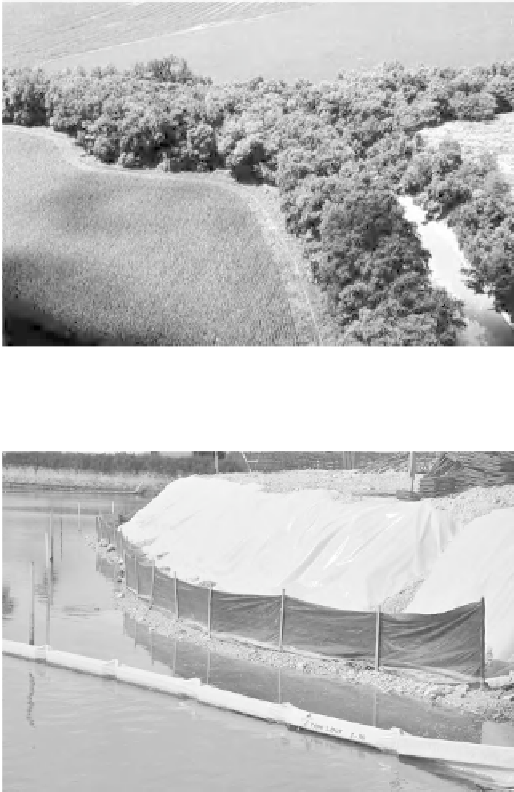Environmental Engineering Reference
In-Depth Information
turbulent flow. Vegetated filter strips are feasible
in low-density developments with small drainage
areas and areas bordering roads and parking lots.
Dense grass needs to be maintained in filter strips,
and gully and channel formation should be
prevented. Grass heights should remain at 15 cm
(6 in.) or greater. Pesticide and fertilizer use
should be limited to the minimum necessary for
dense growth. Filter strips are effective in remov-
ing sediment and sediment-associated pollutants,
such as bacteria, particulate nutrients, pesticides,
and metals. Infiltration can be an important
removal mechanism in filter strips, and many pol-
lutants (including phosphorus) are dissolved or
associated with very fine particles that move into
the soil with infiltrating water. The overland flow
distance at which 100% of the sediment is removed
by a filter strip is called the
critical distance
, and in
a study of Bermuda grass, more than 99% of sand
was removed over a distance of 3 m (10 ft), 99%
of silt over 15 m (45 ft), and 99% of clay over
120 m (400 ft) (Wilson, 1967). It has been demon-
strated that when roadsides are more than 90%
covered with grass, significant sediment and metals
removal can be expected within the first 4 m
(13 ft) of the edge of pavement (Li et al., 2008).
Environmental Corridors and Buffer Zones.
Vege-
tated land adjacent to a receiving water body acts
as a buffer between a polluting urban area and the
receiving water body. These zones are commonly
called
environmental corridors
. These corridors
lose their efficiency if a storm-drainage outlet
bypasses these vegetated areas and discharges
directly into the receiving water body or into a
channel with concentrated flows that is directly
connected to the water body. Treatment processes
for storm runoff, such as vegetated filters, infiltra-
tion basins, detention and retention ponds, and
wetlands, are sometimes incorporated into the
landscape of the corridor.
Buffer strips
made of uneven shoreline vegetation
may also be used to attenuate runoff pollutants
that otherwise would reach the receiving water
body. A typical buffer strip adjacent to a river,
more commonly called a
riparian buffer
, is shown
in Figure 6.10. Typical widths of buffer strips in the
United States and Canada are in the range of
10-30 m (30-100 ft).
Sediment Barriers and Silt Fences.
These are small
temporary structures used at various points within
or at the periphery of a disturbed area to detain
runoff for a short period of time and trap heavier
sediment particles. Sediment barriers are built
Figure 6.10.
Riparian buffer strip.
Source
: Natural Resources
Conservation Service (2005a).
Figure 6.11.
Silt fence.
with a variety of materials, such as straw bales,
filter fabric attached to a wire or wood fence, filter
fabric on straw bales, and gravel and earth berms.
These barriers are placed in the path of sediment-
laden runoff, commonly from construction sites
and surface mining. A typical silt fence is shown
in Figure 6.11. Silt fences remove sediment pri-
marily through sedimentation, and filtration
removal is secondary. The widely used alternate
name “filter fence” to refer to a silt fence is mis-
leading and can detract from viewing the system
as a means of forming a temporary detention
basin. Any effort to increase the storage volume
behind silt fences, such as the use of tiebacks at
the ends of the silt fences (Zech et al., 2008), will
help increase the overall effectiveness of the
system. Well designed silt fences that maximize
removal through sedimentation in conjunction
with filtration will produce the most optimal
results.

Search WWH ::

Custom Search